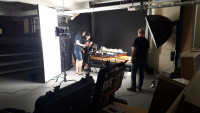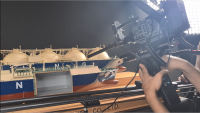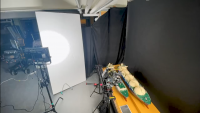Maritime Innovation In Miniature
Interview with Roberto Vivancos, Director of Photography.
Have you always been interested in models – in the world represented in miniature?
I’ve always been fascinated by models and life in miniature since I was a kid. My earliest introduction to this world were the train dioramas that I used to build with my dad, then later building Second World War scenes with him, painting and creating intricate battle scenes complete with armies and artillery was a great memory.
In my teenage years, I became a collector of Star Wars figures and Mcfarlane comic miniatures. I remember when the first consumer digital cameras came out, the 0.35 megapixel HP Photosmart, which seems ridiculous these days but at the time was a technology breakthrough. This was one of the first cameras that came with the ability to shoot video. I created a fan-made Blink 182 music video, using all my models and bringing them to life which was probably my first foray into the world of cinematography back in 1997.
What are the particular challenges of filming ship models?
One of the biggest challenges when filming these models is the logistics, as you are working with such delicate, detailed, unique and old models. My crew and I need to be extremely careful when positioning and securing lights, grip and camera, meticulously measuring distances, as one of the lenses we are using is particularly long physically, and we need to get extremely close to the model itself to achieve the desired effects of proportion and magnitude.
Another challenge is to keep the shots dynamic and interesting, some of the models we are filming are very detailed, for example some include both the model and a diorama of a whole town, which gives me a lot of creative opportunities visually, however other times we have to play with lighting and cinematic tricks to make the shots more appealing.
As a cinematographer, a static subject often poses more challenges bringing it to life. Still further I do feel the difference when shooting these models as opposed to, let’s say a product commercial, as with the latter you can physically manipulate the subject and bring in external effects such as water, haze, props etc. to achieve a more dynamic shot. The fact I can’t rely on these ‘tricks’ with these models actually forces me to be more creative - resulting in one of my favourite techniques used in this particular project and animating the shadows using creative and dynamic lighting. I think creative lighting really makes an otherwise static subject burst to life in addition to camera framing and movement.
How do you prepare for a day’s filming?
With each miniature I start by researching the history of the original ship to identify its story, its main features and points of interest. Following this I do additional research on the physical features of the miniature itself, usually there is not much documentation online so I do a recce to study the model’s size, the materials it is made of, whether it is reflective or matt, does it come with a covering glass we can remove, is the base of the model too big to make the tighter shots difficult etc, and also very importantly recce the room we are going to shoot in, ascertain how much ambient light we have and the need to block it to have total control of the lighting is also key.
Dr. Sam Willis writes the script, and with this in mind I start creating the shot list and share with the team, after this, we prepare the equipment list. Having my own production company, Little Big Studios, makes the process easier as we already have an extensive lighting and grip kit so we normally don’t need to outsource any additional equipment, however each model has very individual grip requirements so we tailor the EQ very carefully for each film date. At this point the crew gets involved (a gaffer and a runner/assistant) and after a few team meetings with crew and director we are all ready to go.
What is involved in a day’s filming?
We normally have a very early start, grabbing the van and collecting the equipment from my studio that we’ve prepared and tested the night before. Some of the models are based in London where we are, however others are further afield so of course it requires more planning for driving logistics, accommodation etc. As these models are often delicate antiques we go to the models not the other way around!
After arriving on location, we first load in the equipment, black out the room, set up the lighting, and run some tests - this process normally takes an hour or so. After this we are ready to start shooting. We group the shot list into similar shoot types so it makes the shooting process more streamlined to minimise lighting changes, changes of rig/lenses and orientation of the miniatures themselves.
After a long filming day we wrap and pack everything to head back to our studios.
What equipment do you use?
Our main camera is a Sony FX6 but we also use Sony A7SIII as camera B for pickups and more static shots. It's great to work with these two together as they have a very similar picture profile and produce virtually identical Slog-3 footage which makes things easier for editing and colour grading later on.
We also use a combination of different prime lenses with different focal lengths: 35mm, 50mm, 85mm and a 90mm macro lens, but the jewel of the crown is our Laowa 24mm F14 2x Macro Probe Lens, which due to its minimum focus distance and it’s long and thin shape can be used to get really close and into the smaller cavities of the model. This lens is not all whistles and bells though, as it has a very small maximum aperture of F14, meaning there is not much light that can pass through its diaphragm so it requires extremely powerful lights to expose correctly, this fact is also aggravated when shooting at faster fps for slow motion. Otherwise we will end up with an underexposed image.
These specialised cameras and lenses, combined with the motorised slider and shooting at a very high FPS speed allow us to create a beautifully stable and smooth slow motion footage making it feel like we are submerged in water, almost as if we were floating gently past the miniatures as we take in the scene.
How does the editing process work?
I find the editing workflow quite streamlined thanks to the use of the latest editing and review tools such as Davinci Resolve and frame.io. It’s during this iterative process that we have a number of reviews and feedback passes with Dr. Sam Willis. Using these advanced and complex yet user friendly tools in addition to the fact that we both share a mutual creative vision of the project, makes this a fairly slick process.
It is at this stage of the workflow process that Dr. Sam’s narrative script is recorded by our voice artist Alison Garner and woven into the piece. Having such a talented voiceover artist who understands and can articulate the technical and historical facts whilst simultaneously making the content engaging and exciting for the audience is extremely important for us. This in conjunction with our tailored maritime ambient sound design brings the whole visual together allowing the audience to immerse themselves in a cohesive cinematic experience.
What do you enjoy most about this project?
Having front row access to these incredible miniatures, some of which are restricted to the public, is an enormous honour. Dr Sam and his extensive knowledge in the field combined with the trust in which the foundation has placed in the expertise of our team to create something beautiful, really makes for something quite unique. The creative freedom of this project is something I really appreciate allowing us to work with the latest technology available and playing with dynamic light setups to really show the world these stunning models, full of history and lore.
From this series of miniature maritime models, I hope people learn from the technological wonders that engineers, physicists and architects have built through the centuries and the challenges they overcame and apply this knowledge for future generations.
For more of Roberto Vivancos’ work please visit www.robertovivancos.com and littlebigstudios.uk




